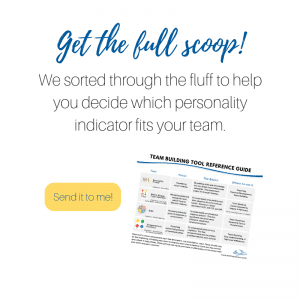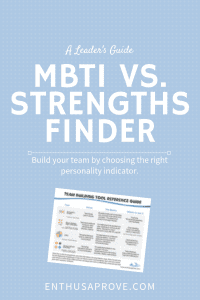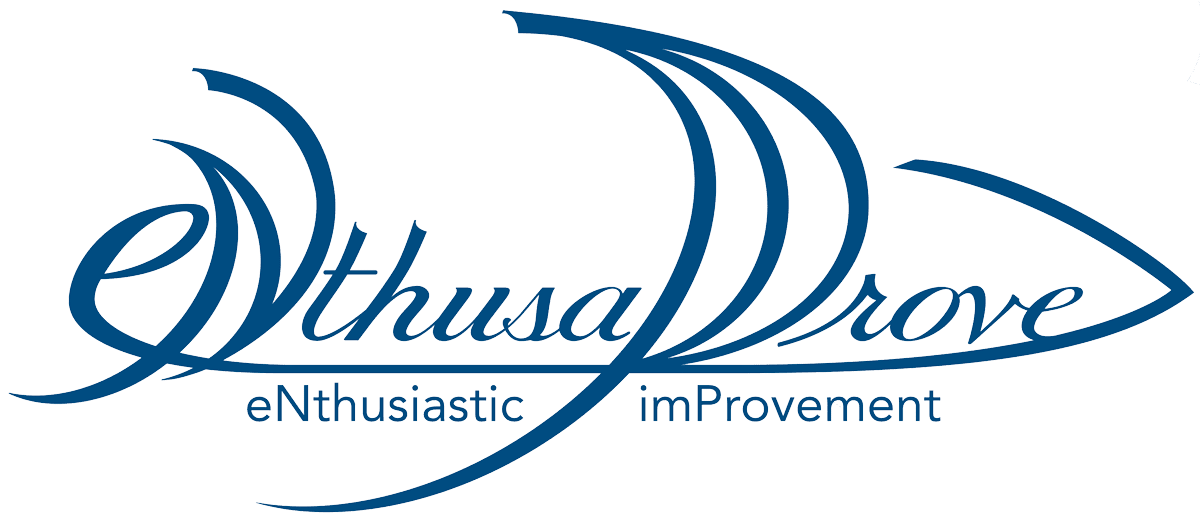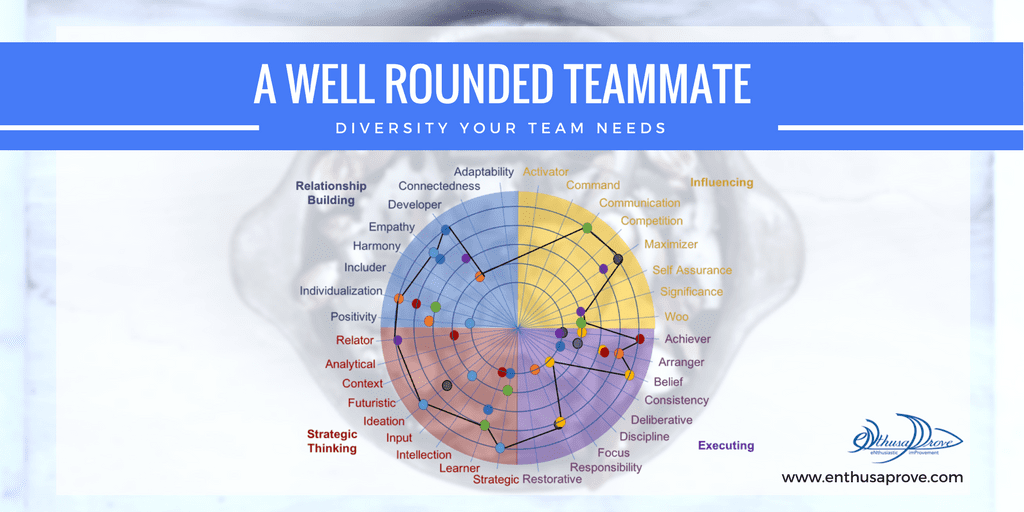
Have you heard of Myers-Briggs? Do you get excited to look into your personality, your preferences, and communication style?
I have found that most team leaders do. I regularly see quizzes on Facebook claiming to tell you what Disney Princess you are, what Muppet character, or what color your aura is…
Whether we’ve taken quizzes on Facebook, at work with a team, or have read books about it, you’ve probably gained some insight into your “style.” So, is this just a journey of self-exploration or is it really useful in our teams?
Paul & I have used the Myers-Briggs Type Indicator (MBTI) to help many teams improve their communication, both internal within a team and how the team communicates with stakeholders. We’ve been Myers-Briggs Type Indicator qualified administrators for more than 10 years and have found great value in helping people see how they get data and make decisions.
We are digging deeper into the StrengthsFinder exercise as well. It’s a cool idea that we see as highly valuable to teams. The basic theory is each person has talents that, if cultivated, can become extraordinary strengths.
Do StrengthsFinder and Myers-Briggs work together?
A friend who was coaching me on StrengthsFinder recently asked me this question… do StrengthsFinder and Myers-Briggs work well together?
As we both have the Learner strength, it wasn’t surprising for us to spend the time learning from each other. We discussed how Myers-Briggs and Strengths Finder are both heavily researched and validated tools. They’ve stood the test of time and remain valuable. They both describe preferences, so…
Do they speak to different things or are they the same thing in different packaging?
As I’ve learned about each tool, I find that they look at different things.
- Myers-Briggs Type Indicator (MBTI) focuses on how each person thinks. This is described in the two core functions, getting data (Sensing or Intuition) and making decisions (Thinking or Feeling). Therefore, MBTI helps us understand our own and other’s thought processes. By understanding our preferences, we can communicate more effectively. Also, I’ve found that I have more grace for those that have different preferences than my own.
- StrengthsFinder looks at talents. These are latent within us, and when we invest in developing them we can exponentially increase our effectiveness in them.
How do they help?
 Since MBTI and StrengthsFinder look at different aspects of cognition and action, I would use them for different team scenarios (and could foresee using both for a single team).
Since MBTI and StrengthsFinder look at different aspects of cognition and action, I would use them for different team scenarios (and could foresee using both for a single team).
Does your team need help to understand each other? I would bring Myers-Briggs to the table for this team. When there is conflict from miscommunication or misunderstood teammates, Myers-Briggs is very effective at helping teams see the underlying causes of the confused or offended looks between teammates.
Need help developing your team? This is where Strengths Finder really shines. It helps each teammate find where they can be a rock star, being not just good, but great at something. Also, teams can see where the gaps are in strengths and seek out help with those functions.
Leading a Team Using Strengths
If you use StrengthsFinder with your team, what would you be doing?
Strengths are all about latent talents. Therefore, it’s useful to know where teammates are gifted (and where there might be gaps). As a Team Leader, you can use StrengthsFinder in two ways:
- Your Gifts: Through the coaching process you validate what your personal gifts are, which leads you to explore your most effective way of leading. When you understand your gifts, you can see more clearly what assignments are good for you to take and which ones to delegate.
- Your Team’s Gifts: When you lead a team through exploring strengths, there are two benefits. First, you can learn how to develop each person on the team, and where they will shine. This helps in effectively assigning roles, work tasks, and looking for development opportunities. Second, you can study the mix of gifts represented and look for any gaps in critical skills. If your team is greatly lacking in a necessary skill, you need to look at options for how to bolster the team by taking actionable steps through getting additional help (add teammates, outsource, etc.).
One of the most freeing parts of learning your strengths is giving yourself permission to not focus on your weaknesses. It’s popular to say that it’s good to be well-rounded, and a certain degree of understanding of all things is a good thing. Even so, we cannot be all things to all people because we will be spending effort on things that return very little value (our weaknesses).
Our efforts are best spent investing in our natural talents so that through building knowledge and skill, our talent becomes a strength. This is true for yourself as a leader and your team as you empower them for their next job.
What if you have a glaring hole in your strengths? For example, you have strengths focused on influencing strengths, and a gap in strategic strengths. That means you will be great at connecting with others and bringing them to your point of view.
You wouldn’t develop a 10-year plan where the organization should go to be successful. As a leader, there is a certain amount of strategic thinking that’s needed.
This would lead you to look for help in finding a direction to apply your rock-solid influence. I think that using strengths this way, to offset your weaknesses, is an insightful application of the saying, “Hire people smarter than you.” When we bring people in that possess strengths that we don’t have, the team benefits.
It frees us all up to operate more often in our strengths, which will increase the overall ability of the team.
Leading a Team with Myers-Briggs
 If you use Myers-Briggs with your team, what would you be doing?
If you use Myers-Briggs with your team, what would you be doing?
MBTI is about how we think. We constantly take in information and make decisions, these are the core functions described in MBTI. Therefore, it is useful to see how you and others think.
- Team Leader Preferences: When you understand your own preferences for how to get information and what rule book you use for making decisions, it is easier for the team to prepare information for you. You learn to appreciate your non-preferences and even seek out feedback from others with your non-preferences to give you a more complete picture.
- Your Team’s Preferences: A group comes together to work together and sometimes communication can be clumsy and cause lots of questioning looks. As part of growing as a team, the MBTI sheds light on reasons why it might be clumsy and give insight into how to make it better, rather than writing others off as “hard to deal with” or “annoying.”
A session on MBTI is two things: understanding your preferences and adjusting to meet other’s preferences. If you only seek to understand yourself, you only see a small portion of the power of MBTI. The real power comes when you use it to relate to others. I’ve seen many people learn their type and then use it as an excuse for all sorts of things, like a shield of sorts.
Rich use of MBTI doesn’t end with understanding yourself. They aren’t prescriptions that reduce us to 16 types of robots. Personal experience tells us that can’t be true. It provides us with the ability to have a conversation with someone. It’s a tool to get us going in the right direction which leads to better communication.
The biggest critique we hear about MBTI is that it puts people “in boxes”. Our experience shows that this usually happens when the MBTI is reduced to a Facebook or BuzzFeed style quiz. People see it as a jail cell rather than a starting point in getting to know someone. We’ve found that understanding the way someone else approaches and processes information and decision making is the precursor to better understanding each other, and therefore working together effectively.
The Team Leader’s Job: Enabling Joy in Work
We all want to be part of something great, and we want our contribution to mean something. MBTI and Strengths Finder are effective tools to build more effective teams, which we find extremely helpful to our clients.
As a Team Leader, your mission is to enable joy in work. At eNthusaProve, we believe that people find joy in work when they use their natural talents and communication methods to help the team be effective. Does your team need to see where your strengths are, so you can exponentially increase your effectiveness? We would love to talk to you about how to effectively equip your team for rockstar performance.
We created a resource guide to help you see the pro and cons of using the top 5 personality/communication style indicators that we would love to send you!
Related Posts:








